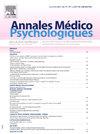Santé mentale des minorités sexuelles : disparités, modèles et interventions
IF 0.5
4区 医学
Q4 PSYCHIATRY
引用次数: 0
Abstract
Objectives
The term sexual minorities refers to an aggregation of various minority groups defined on the basis of sexual orientation, the main ones being lesbians, gays, bisexuals and asexuals. In the field of psychology, there is little research into sexual minorities. Moreover, they are mainly conducted in Anglo-Saxon countries. The limited amount of research on the subject in France is the result of a principle of equality implicit in the scientific community, according to which minority specificities must be erased in favour of an overall perspective that is intended to be non-stigmatising. However, the erasure of these specificities makes the specific needs of sexual minorities invisible and contributes to a gap in the effectiveness of the care offered compared to the sexual majority. The aim of this article, from a psychopathological perspective, is to examine the link between mental health and sexual minorities and to analyse the various interventions tailored to sexual minorities that can reduce psychopathological difficulties. If psychotherapists were to take these specific characteristics into account, they would be able to provide better care for this population and consequently reduce the risk of mental disorders developing or persisting.
Methods
The literature review was carried out on the EBSCOHOST and CAIRN databases using the following keywords “sexual minorities OR LGBT+ OR homosexuality OR bisexuality OR asexual”; “mental health OR mental disorders OR psychiatric disorders OR depression OR anxiety OR PTSD OR well-being OR social well-being”.
Results
The proportion of sexual minorities in the general population depends on the age of respondents. People born after 1997 identify more as a sexual minority than those born before 1948, with an increase in bisexual identity. Sexual orientation conceptualization could include sexual fluidity and gender expression along with sexual identity, sexual behaviour, romantic attraction and sexual attraction. Sexual minorities are more likely to present depressive and anxiety symptoms and disorders, eating disorders such as anorexia, bulimia and binge eating, and post-traumatic stress disorders. Bisexuals and asexuals are particularly affected. Other minority statuses are also factors to be taken into account. The minority stressors model explains these differences by the pressure of the stigmatising environment and the individual resources available. The closet model approaches them from a developmental point of view. This model, built around coming out, articulates the effect of a stigmatising environment prior to awareness of sexual orientation, awareness which can lead to concealment, and revelation and affirmation of orientation. The interventions identified to directly reduce the psychopathological difficulties of sexual minorities focus on affirmation in the form of psychotherapy. Such therapy aimed the valorisation of one's sexuality. The interventions that seek to indirectly reduce psychological difficulties focus on reducing discriminatory behaviour through education or by modifying the environment. Approaches that focus on minority strengths enable the minority experience to be revalued by improving self-esteem. In addition, the minority strengths model emphasises the important role played by proximity to the community in the development of healthy mental health.
Discussion
The research sometimes lacks robustness and therefore requires the development and use of validated and standardised tools and methods. Most of the research has been carried out with homosexual men, despite the diversity of the public grouping under the term sexual minorities. More recently recognised sexualities, such as bisexuality and asexuality, are the most invisible. The majority of interventions are not yet validated or require a greater variety of methods and populations for validation. The interventions identified occur either after exposure to stress or before the stressful event. Minorities dedicated therapies value the coping resources of sexual minorities and thus allow them to resist minority stress. Some studies have shown that acceptance of one's sexual identity, or at least a positive perception of this identity, is central to adapting to stress. Dedicated therapies therefore seem to be almost essential for the positive reinforcement of identity through valorisation. Of course, these therapies are not substitutes for training professionals on minority stress (psychologist, psychiatrist, doctor, nurse, etc.). Therapies focus on valuing identity while training professionals provides a different perspective on the patient's pathology but also on their attitude towards them “as affirmative perspective can propose”. This latter being more in line with an inclusion approach. Current models focusing on the mental health of sexual minorities concentrate on minority stress and the disclosure of sexual orientation, placing them within the context of individual resources and life circumstances. However, these models remain centered on pathology. Adopting a more positive approach to minority sexualities would allow minority issues to be removed from the realm of pathology and thus revalued. Identifying their strengths is a first step towards valuing their uniqueness and towards a more complete and balanced portrait of this population.
Conclusion
Future research should focus on the quality of the methods used both experimentally and clinically, the inclusion of minority publics and propose a more positive perspective of the minority experience.
性少数群体的心理健康:差距、模式和干预措施
性少数群体一词是指根据性取向定义的各种少数群体的集合,主要是女同性恋、男同性恋、双性恋和无性恋。在心理学领域,对性少数群体的研究很少。此外,它们主要在盎格鲁-撒克逊国家进行。法国对这一问题的研究数量有限,这是科学界隐含的平等原则的结果,根据这一原则,必须消除少数群体的特殊性,以有利于非污名化的整体观点。然而,这些特殊性的消除使得性少数群体的特殊需求被忽视,并导致与性多数群体相比,所提供的护理的有效性存在差距。本文的目的是从精神病理学的角度来研究精神健康与性少数群体之间的联系,并分析针对性少数群体的各种干预措施,这些干预措施可以减少精神病理方面的困难。如果心理治疗师考虑到这些特定的特征,他们将能够为这一人群提供更好的护理,从而降低精神障碍发展或持续的风险。方法以“性少数或LGBT+或同性恋或双性恋或无性恋”为关键词,对EBSCOHOST和CAIRN数据库进行文献综述;“精神健康或精神障碍或精神障碍或抑郁或焦虑或创伤后应激障碍或健康或社会福利”结果性少数群体在总人口中的比例与调查对象的年龄有关。1997年以后出生的人比1948年以前出生的人更容易被认为是性少数群体,双性恋身份增加。性取向概念化可以包括性流动性和性别表达,以及性身份、性行为、浪漫吸引力和性吸引力。性少数群体更有可能出现抑郁和焦虑症状和失调,饮食失调,如厌食症、贪食症和暴饮暴食,以及创伤后应激障碍。双性恋和无性恋者尤其受影响。其他少数民族地位也是需要考虑的因素。少数压力源模型通过污名化环境和个人可用资源的压力来解释这些差异。衣柜模型从发展的角度来看待他们。这个模型是围绕出柜而建立的,阐明了在意识到性取向之前的污名化环境的影响,意识到性取向可能导致隐藏,揭示和肯定性取向。直接减少性少数群体心理病理困难的干预措施侧重于心理治疗形式的肯定。这种治疗的目的是使一个人的性取向更加稳定。寻求间接减少心理困难的干预措施侧重于通过教育或改变环境来减少歧视行为。关注少数群体优势的方法可以通过提高自尊来重新评估少数群体的经历。此外,少数民族优势模型强调了与社区的接近在发展健康的心理健康方面发挥的重要作用。研究有时缺乏稳健性,因此需要开发和使用经过验证的标准化工具和方法。大多数研究都是在同性恋男性中进行的,尽管在性少数群体这一术语下的公众群体是多种多样的。最近被承认的性行为,如双性恋和无性恋,是最不可见的。大多数干预措施尚未得到验证,或需要更多种类的方法和人群进行验证。确定的干预措施要么发生在压力暴露之后,要么发生在压力事件之前。少数群体专用治疗重视性少数群体的应对资源,从而使他们能够抵抗少数群体压力。一些研究表明,接受一个人的性别身份,或者至少是对这种身份的积极认知,是适应压力的核心。因此,专门的治疗方法似乎对于通过价值增值来积极强化身份几乎是必不可少的。当然,这些疗法并不能代替对专业人员(心理学家、精神病学家、医生、护士等)进行少数民族压力方面的培训。治疗侧重于重视身份,而培训专业人员则提供了对患者病理的不同观点,以及他们对他们的态度“作为肯定的观点可以提出”。后者更符合包容性方法。 目前关注性少数群体心理健康的模式侧重于少数群体的压力和性取向的披露,将其置于个人资源和生活环境的背景下。然而,这些模型仍然以病理学为中心。对少数群体的性行为采取更积极的态度,将使少数群体问题从病理学领域中移除,从而重新得到重视。确定他们的优势是评估他们独特性的第一步,也是对这一群体进行更全面和平衡描述的第一步。结论未来的研究应注重实验和临床方法的质量,包括少数群体公众,并提出更积极的少数群体经验视角。
本文章由计算机程序翻译,如有差异,请以英文原文为准。
求助全文
约1分钟内获得全文
求助全文
来源期刊

Annales medico-psychologiques
医学-精神病学
CiteScore
1.30
自引率
33.30%
发文量
196
审稿时长
4-8 weeks
期刊介绍:
The Annales Médico-Psychologiques is a peer-reviewed medical journal covering the field of psychiatry. Articles are published in French or in English. The journal was established in 1843 and is published by Elsevier on behalf of the Société Médico-Psychologique.
The journal publishes 10 times a year original articles covering biological, genetic, psychological, forensic and cultural issues relevant to the diagnosis and treatment of mental illness, as well as peer reviewed articles that have been presented and discussed during meetings of the Société Médico-Psychologique.To report on the major currents of thought of contemporary psychiatry, and to publish clinical and biological research of international standard, these are the aims of the Annales Médico-Psychologiques.
 求助内容:
求助内容: 应助结果提醒方式:
应助结果提醒方式:


